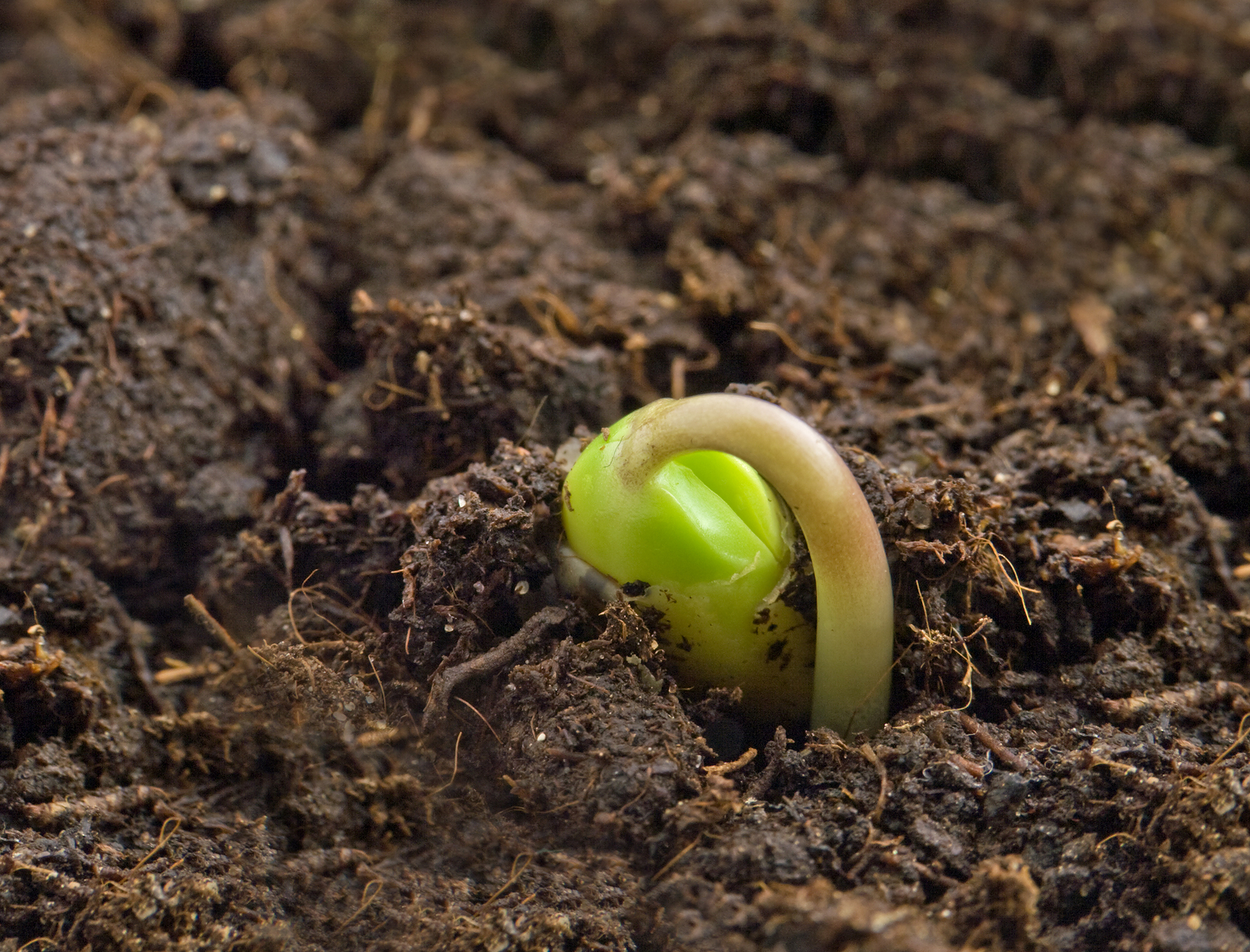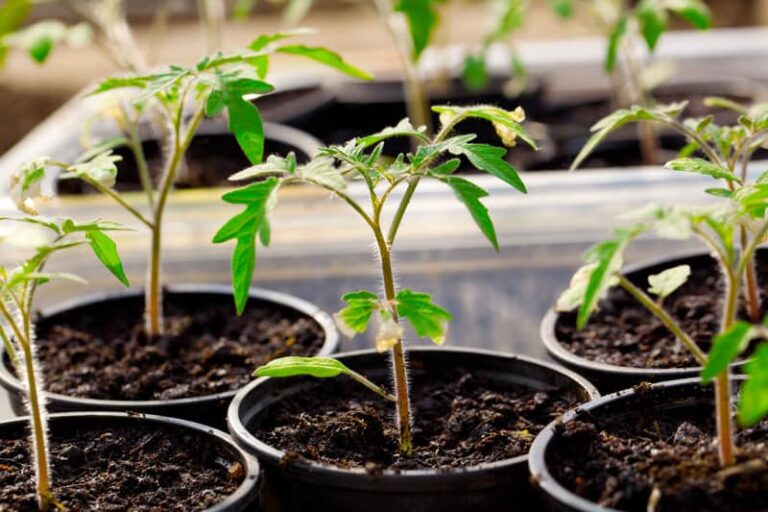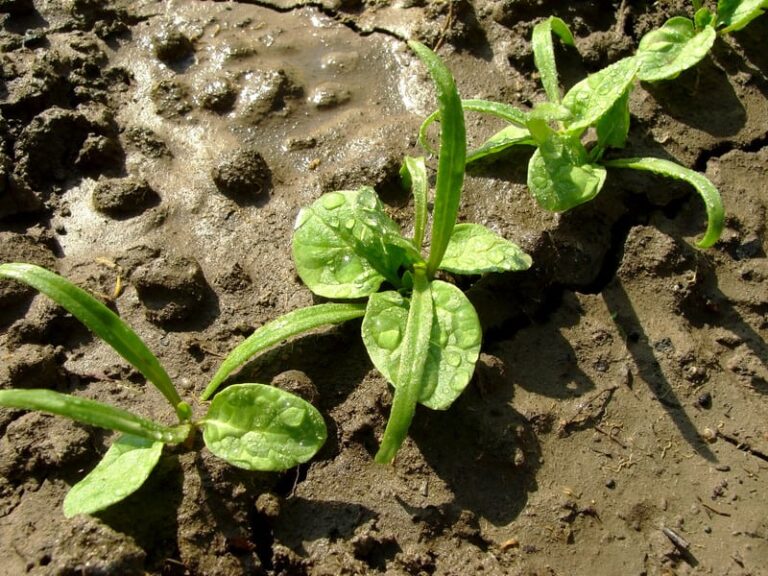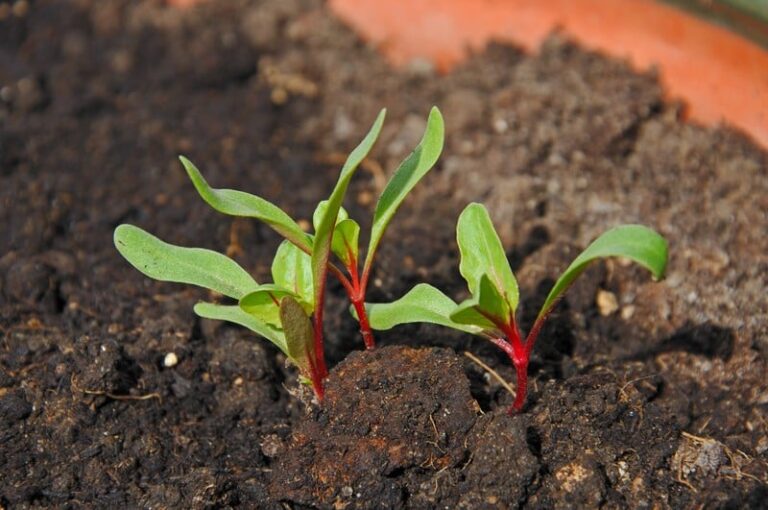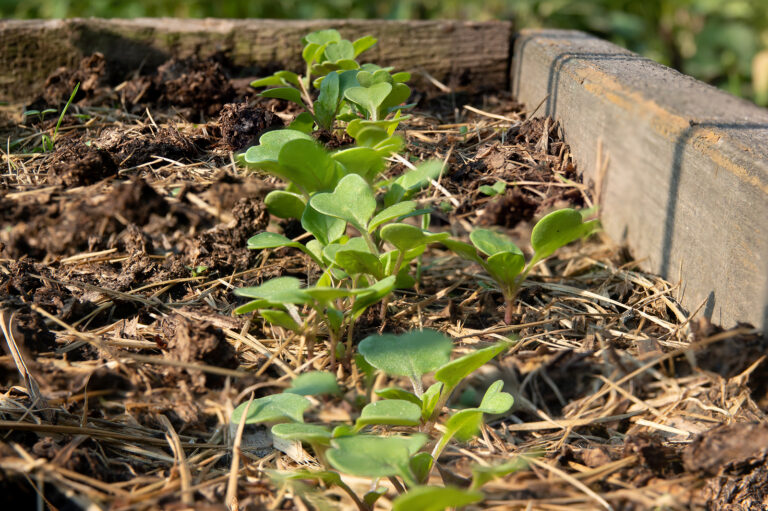Seed and Seedling Failure Troubleshooting
Successful seed and seedlings’ growth depends on moisture, warmth, air, and light. Seeds and seedlings require optimal temperatures, even watering, open-air circulation, and bright light to thrive.
When a seed fails to sprout or a seedling fails to thrive there is usually a simple and easily correctable reason. Here are the most common reasons seeds and seedlings fail to grow along with troubleshooting solutions.
Seed failure problems
Here are common reasons seeds fail to germinate and thrive.
The soil is too dry
Seeds must absorb moisture to begin germination. The seed coat expands with water and allows the embryo to begin growth. Small seeds sown very near the surface often fail from lack of moisture. They may have enough moisture to germinate, but then the soil becomes so dry that the sprout which is beginning to push out from the seed is dried up. Neglect that would do no harm to seedlings an inch or two high will prove fatal to seeds that are just germinating. Check soil moisture once or twice a day. Keep the soil evenly moist and not too wet. If you are germinating seeds indoors keep containers away from excessive heat or drafts. Cover containers with plastic or glass until seeds sprout.
Good Products for Seed Starting Success at Amazon:
- Jump Start Germination Station w/Heat Mat Tray, 72-Cell Pack, Dome
- Espoma Seed Starting Mix
- 200 Count- Jiffy 7 Peat Soil Seed Starting Plugs
- Seed Starter Kit with Humidity Dome (120 Cells Total Tray)
- AgrobriteT5 Fluorescent, 2-Foot, Grow Light System
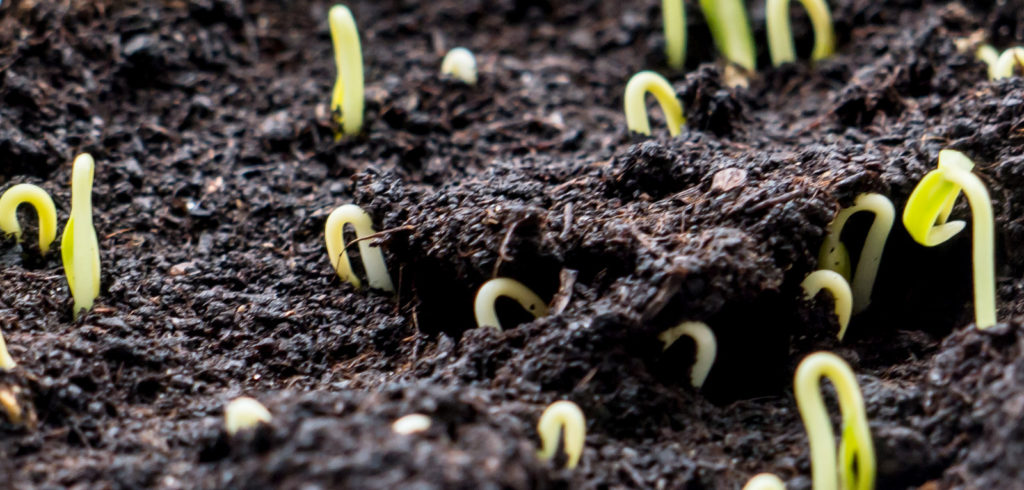
Seeds are covered too deeply
Seeds covered too deep may not have the strength to push through to the surface; they are weakened by the struggle. As a general rule sow seeds one to two times their diameter, this is often just ¼ to ½ inch deep and sometimes less. Most seeds require light to germinate. Check the proper seed sowing depth on the seed packet. Tiny or very fine seeds can be scattered on a potting or seed-starting mix surface and lightly pressed into contact with the mix. Most seeds require light to germinate; some seeds require darkness. Seeds are light-sensitive. Germination often depends on exposure to red light waves–even through soil cover. Check seed packets or grower’s guides to see if special light conditions must be present for germination.
Wrong kind of soil
The best soil is half solid matter and half pore space–the pore space contains air and water. Clay soil is flat with no space for air. Sandy soil is too loose and does not hold moisture well. The best soil should be rich in decomposed organic matter or compost; this soil will have just what seeds and seedlings need. If you suspect the soil is poor, amend the soil with aged compost and re-sow. Ordinary garden soil, especially if it is at all heavy or clayey, is literally too heavy to cover the seeds with. Heavy soil has a tendency to crust when watered making it very difficult for sprouts to emerge. Seeds can not overcome the weight of the soil on top. Light, crumbly soil is best for starting small seeds. Light soil will not crust. Amend outdoor seed beds with humus or well-aged compost. Indoors use a soilless seed starting mix or make a mix using equal parts vermiculite, perlite, and aged compost.
Insufficient soil contact
Seed coats are tough. Beneficial bacteria and fungi in the soil along with moisture help break down the seed coat and allow germination and growth to begin. Gently press down on the soil after you sow the seed to make sure the seed and soil come in contact.
Soil temperature too high or low
The optimal soil temperature for seed germination is from 70 to 75°F. Check seed packets before sowing for the optimal germination temperature. Use an electric heating mat under seed containers or place the containers near a radiator, heat vent, or on top of the refrigerator if the soil temperature is too cool. Water with tepid water; cold water will lower the soil temperature.
Poor drainage
Watering can cause seeds sown just below the soil surface to become exposed and float away. Dampen the soil before you sow seed then be careful not to overwater after sowing. Use a light seed-starting mix and be sure germination containers drain freely. Avoid containers or flats with tight-fitting trays or bottoms which will cause the soil to stay wet and soggy after watering. Garden soil that is too wet or constantly damp will cause many seeds to rot. Be sure to amend seed beds with well-aged compost to make sure the beds are well-drained. Water should soak down below the level of seeds not sit on the soil surface.

Careless watering
Water applied in careless spurts or streams can wash soil and seeds away or leave seeds uncovered and exposed or covered too deeply. As well, too much water may cause the soil to form a hard crust. For seed beds, use a watering can or hose attachment that delivers a fine mist of water. Keep the soil lightly and evenly moist during germination and after seedlings emerge. Check soil moisture once or twice a day and never let the soil dry out. Containers can be watered from below; set containers in water trays for 15 to 20 minutes and allow the water to wick up into the seed-starting mix, after be sure to allow the containers to freely drain.
Damping-off disease
Damping-off is a fungal disease that can attack just germinated plants. Damping-off is often a sign that the soil is too moist or too rich in nutrients. Use a sterile seed starting medium.
Seeds are too old or improperly stored
A seed that is too old will not germinate. Check seed packets for seed vitality and expiration dates. (Seeds lose the strength to germinate over time.) Fresh seeds not used this season can be stored for the next season in a cool, dry place. Seeds stored in a very warm or hot place will lose vitality and may fail to germinate the next season.
You can test the vitality of the seed by sprinkling 10 or 20 seeds between two paper towels moistened with warm water. Fold or roll the paper towels and place one end in a glass containing an inch of water; cover the glass and towel with a clear plastic bag to keep the moisture in and place it in a warm spot. When the average germination time for that seed is up, unwrap the towel and count the number of seeds that have sprouted, and divide by the total number of seeds placed in the towel. This will tell you the germination rate for this group of seeds.
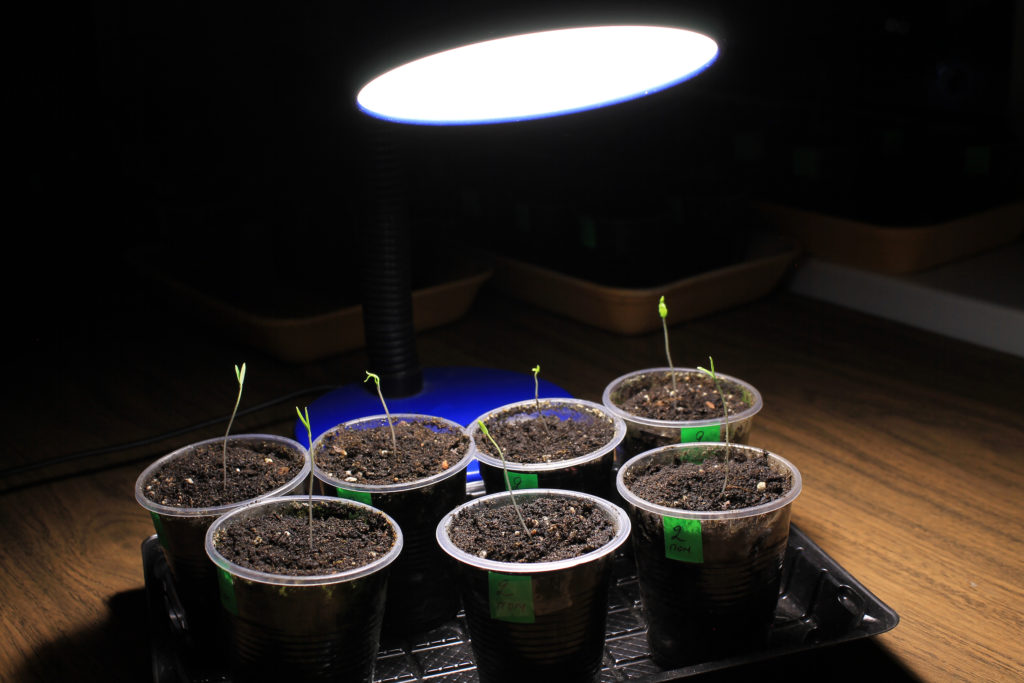
Too much or too little light
Some seeds require light to germinate. Check the seed packet for directions. Seeds that require direct light can be sown on the surface of the potting mix and lightly pressed onto the surface. Some seeds require extra darkness to germinate; cover these seeds with ¼ inch of potting mix and then place black plastic or newspaper over the container until the seeds germinate.
Seed required pretreatment
Some seeds may require a specific pre-treatment: stored in the cold before sowing (cold treatment), soaked in warm or hot water (water treatment) before sowing, or scratching or nicking of the seed coat (scarification) before sowing. Check the seed packet or a growing guide for pretreatment requirements.
Seedling failure problems
Once seeds have sprouted and begun to grow keep the soil just moist–do not overwater or allow the soil to dry out, provide strong light–14 to 16 hours each day–and good air circulation, and avoid over-feeding.
Here are common seedling problems and responses:
Leaf curl
Too much fertilizer will cause leaves to curl, especially in bright light. Decrease the amount of fertilizer and if the problem is severe replant the seedling in fresh potting soil.
Yellow lower leaves
Too much fertilizer can cause leaves to yellow. Avoid overfeeding young plants. Make sure there is good air circulation around the plants.
Leggy plants
A leggy plant has large gaps or spaces between leaves and thin, weak stems. Be sure the plant is getting sufficient light. Don’t let the temperature get too high. Make sure your plants are not overcrowded. A good course of action is to transplant the leggy plant into a deeper container.
Leaf discoloration
Off-colored leaves are often a sign of nutrient deficiency. Pale leaves may be a sign of nitrogen deficiency or lack of enough light. Deep purple veining can indicate a deficiency in nitrogen. Reddish purple undersides can be a sign of phosphorus deficiency; the seedling may also be stunted with thin, fibrous stems. When the soil is too acidic, phosphorus is not taken up from the soil. Bronze or brown leaf edges can be a sign of potassium deficiency or overwatering. When leaf discoloration occurs, repot the seedling into a medium that contains compost. Compost is likely to contain the trace minerals plants need.
Good Products for Growing Seedlings at Amazon:
- Garden Safe Snail and Slug Bait
- Bonide Sulfur Fungicide
- Monterey BT Caterpillar Killer
- Neem Bliss 100-% Cold Pressed Neem Oil
- Safer Brand Insect Killing Soap
- PyGanic Botanical Insecticide
Discolored roots
Discolored roots can be caused by overfeeding or overheating which can result in excess fertilizer salts being released into the soil. Replant the seedlings in fresh soil or leach away the toxic salts. Use well-aerated soil and do not overfeed or overwater.
Mold
Mold on the soil surface is a sign of poor drainage and lack of air circulation. Scratch the soil to increase aeration, and move seedlings to a place with good air circulation. You can also add powdered charcoal to the soil surface.
Insect damage
Identify the insect at work. Prevention is always the best course of action. Avoid overfeeding which can result in excessive green growth which can attract insects such as aphids. Keep the greenhouse or garden free of plant debris which can harbor sowbugs, slugs, and snails. Place plants where there is good air circulation to slow down spider mites. Use yellow sticky traps to control whiteflies. Knock insects off plants with a strong stream of water.
Damping-off
Withered seedlings and plant failure can be signs of the fungal disease damping off. Damping-off attacks plant stems at the soil surface. Too much nitrogen and moisture can result in damping off. Too little air circulation can also lead to damping-off. Prevention is the only course of action: maintain good air circulation, avoid overwatering, sow seeds in a sterile medium, and pre-soak seeds in water with a tablespoon of clove oil or crushed garlic cloves added–these have anti-fungal properties.
Poor root growth
If transplants fail to root well then several factors may be at play: poorly drained soil, insufficient soil fertility, over-fertilization, the temperature is too low, seed starting medium, or soil insufficiently aerated. Repot the seedling in a sterile potting mix and protect the seedling from broad swings in temperature. Keep the soil mix just moist.
Related articles:
How to Thin Vegetable Seedlings
Vegetable Garden Diseases Problem Solver
Vegetable Garden Organic Weed Control
Vegetable Garden Organic Pest Control
Garden Planning Books at Amazon:

